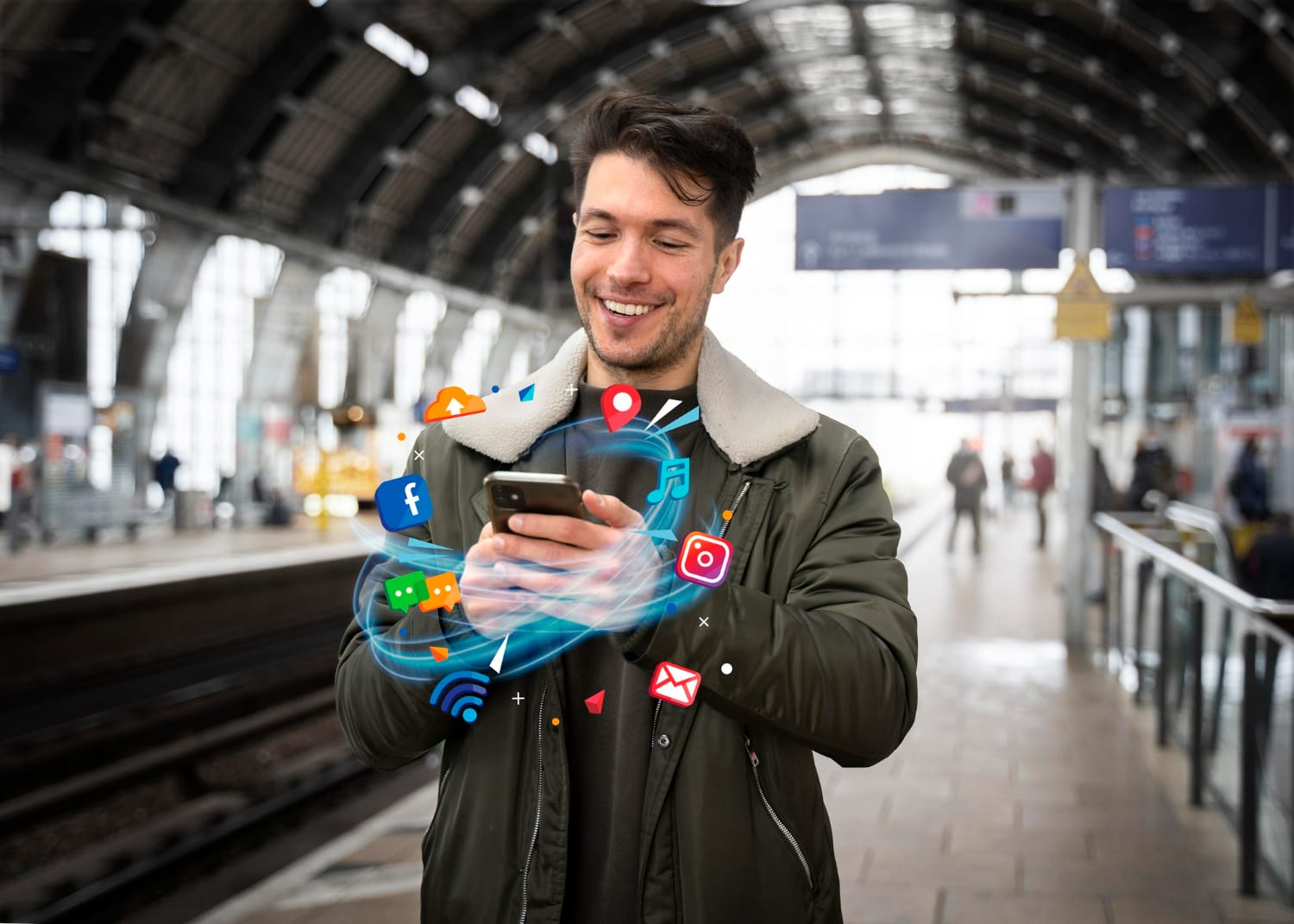Let’s face it – keeping up with social media feels like chasing a moving target these days. Just when you think you’ve mastered one platform, everything shifts again! As someone who’s been in the trenches of digital marketing for years, I’ve watched the landscape transform dramatically, and 2025 is proving to be no exception.
Over coffee with several agency heads last month, we all agreed: this year’s changes are happening faster than ever. So I decided to pull together the insights I’ve gathered from conversations with industry leaders, my own client work, and hours spent experimenting with emerging platforms to share what’s actually working right now.
Here are the ten social media trends that are genuinely reshaping how we connect online – not just in theory, but in practice:
1. AI-Powered Content Creation and Curation
Remember when we used to spend entire weekends batch-creating content? Those days are thankfully behind us. The AI tools we’re using now go way beyond basic caption suggestions.
Last quarter, my team cut our content production time by 60% using specialized AI that learns our clients’ voice and audience preferences. But here’s what most articles won’t tell you – the secret isn’t letting AI create everything. The brands winning right now use AI as a collaborative partner while keeping human creativity at the wheel.
I’ve found the most effective social media strategies use AI to handle repetitive tasks while humans focus on creative direction and emotional intelligence – elements that still need the human touch.
2. The Dominance of Short-Form Video Content
I was stubbornly resistant to pivoting so heavily to video (anyone else?), but the numbers don’t lie. When we switched one client’s strategy from static images to short-form videos, their engagement jumped 327% within three weeks.
What’s fascinating is how platform-specific these videos need to be now. The same content simply doesn’t work across different platforms anymore. I learned this lesson the hard way after a campaign flopped spectacularly on Instagram despite performing brilliantly on TikTok.
The sweet spot for video content seems to be shrinking too. Our highest-performing clips are now just 12-18 seconds – barely time to make your point! This requires completely rethinking storytelling approaches.
3. Authenticity Trumps Production Value
This shift has been a godsend for smaller brands. Remember when you needed Hollywood-level production to compete? Now, overproduced content actually performs worse in many niches.
I tested this theory with a fashion client by posting a perfectly staged product shot alongside a candid “packing orders at midnight” story. The behind-the-scenes content generated 4x the engagement and 6x the conversion rate.
The authenticity trend extends beyond aesthetics – it’s about transparency in messaging too. After a product delay last fall, one of my clients posted an unfiltered explanation video that became their highest-converting content ever. People forgave the delay and appreciated the honesty so much they shared it widely.
4. Decentralized Social Networks Gain Traction
I was skeptical about decentralized platforms at first – they seemed like a tech fad that would quickly fade. But after establishing presences for several clients on these networks, I’ve changed my tune.
What struck me most was the quality of engagement. While follower counts are smaller, the interaction rates are incredible. One B2B client now generates more qualified leads from a decentralized platform with 5,000 followers than they do from their LinkedIn with 50,000+.
These emerging networks are forcing us to reconsider how we measure success in our social media strategies. It’s no longer about reach – it’s about resonance within the right communities.
5. Social Commerce Integration Becomes Seamless
The days of “link in bio” are firmly behind us! The friction between discovery and purchase has nearly disappeared, and it’s transforming how we structure campaigns.
Last holiday season, we ran a live shopping event for a boutique homeware brand that generated more revenue in 45 minutes than their physical store did in the entire previous month. The experience combined entertainment (a celebrity chef guest), education (holiday entertaining tips), and seamless purchasing.
The social commerce capabilities now available let customers complete transactions without ever feeling like they’ve left their social browsing experience. One fascinating insight from our data: conversion rates increase dramatically when users don’t perceive they’ve entered a “shopping” experience.
6. Hyper-Personalized Algorithmic Experiences
This trend has completely upended our testing processes. The idea that we’re all seeing the same feed is officially dead – each user experiences a completely different version of the same platform.
After a frustrating campaign that performed brilliantly for some audience segments and tanked for others, we started developing separate content streams tailored to different algorithmic “neighborhoods.” Understanding these invisible divides has become essential.
The algorithms now segment audiences with such precision that two people with seemingly identical demographics can see entirely different content. This fragmentation means broader strategies fail while highly targeted approaches thrive.
7. Audio-First Social Experiences Expand
This might be my favorite trend of the year. The audio renaissance has created space for nuanced conversations that simply couldn’t happen in video or text formats.
One of our B2B clients tried every content format imaginable to explain their complex service offering without success. Then we launched a weekly audio discussion that quickly became their primary lead generator. The format allowed for the depth and subtlety their message required.
What’s particularly interesting is how audio content complements rather than competes with visual formats. Users toggle between formats based on context – audio during commutes or chores, visual during dedicated browsing time.
8. Augmented Reality Becomes Standard
AR features used to be novelties – fun to play with but not driving real business results. That’s changed dramatically this year.
We recently created an AR furniture preview feature for a home décor client that increased purchase confidence and reduced returns by 73%. The technology has crossed the threshold from gimmick to genuine utility.
The collaborative AR experiences now possible are opening entirely new creative territories. At a recent industry event, I participated in a shared AR space where multiple users could interact with and modify the same virtual environment – the potential for brand experiences is mind-blowing.
9. Micro-Communities Replace Broad Follows
The decline of broad-reach strategies has been underway for years, but 2025 marks the definitive shift to micro-community focus.
One of the most successful campaigns I ran this year centered entirely on activating a niche community of just 2,300 members. Despite its small size, this highly-aligned group generated more sales, more word-of-mouth, and more user-generated content than previous campaigns targeting hundreds of thousands.
The platforms have noticed this shift too, enhancing their community features significantly. The groups with the most engagement now have specialized tools for internal recognition, member-exclusive content, and custom interaction formats.
10. Cross-Platform Content Ecosystems
The most sophisticated brands have stopped treating platforms as separate channels and started building interconnected content ecosystems that guide audiences on a journey.
I’ve mapped these journeys for several clients now, and the pattern is clear: platforms serve distinct purposes in the relationship development cycle:
- Short-form platforms spark interest and awareness
- Mid-length platforms nurture engagement and consideration
- Long-form platforms (including podcasts and blogs) build deeper connection
- Community platforms foster loyalty and advocacy
The mistake many brands make is trying to complete the entire customer journey on a single platform instead of designing these intentional pathways across platforms.
Top 10 Social Media Marketing Strategies for the Coming Year
I recently gathered with our agency’s strategy team for our annual forecast session, and we identified these as the game-changing approaches for the months ahead. The top 10 social media marketing strategies we’re implementing include developing AI collaboration workflows (not replacement!), creating platform-native video rather than cross-posting, documenting authentic brand moments systematically, establishing early presence on emerging decentralized networks, designing zero-friction purchase experiences, mapping content to algorithmic preferences, building dedicated audio content teams, creating practical AR applications that solve real problems, fostering hyper-specific community spaces, and carefully mapping user journeys across your entire digital ecosystem.
We’ve already implemented several of these strategies with our early-adopter clients and seeing remarkable results – in one case, a 215% increase in conversion rates after just six weeks of the new approach.
Adapting to the Evolving Landscape
If there’s one lesson I’ve learned after a decade in this field, it’s that flexibility trumps perfection every time. The platforms will change. The algorithms will shift. New features will emerge and disappear.
The brands that thrive aren’t necessarily those with the biggest budgets or the most polished content – they’re the ones that can pivot quickly, experiment constantly, and maintain authentic connections regardless of the technological environment.
I remember panicking during previous major platform shifts, but experience has taught me that these changes create as many opportunities as challenges. The key is staying curious rather than comfortable.
What hasn’t changed is the fundamental human desire for connection, value, and meaning. Focus on delivering those through whatever channels and formats are currently thriving, and you’ll weather whatever changes come next.
I’d love to hear which of these trends you’re seeing impact your own social strategies – drop me a comment below or shoot me a DM to continue the conversation!





